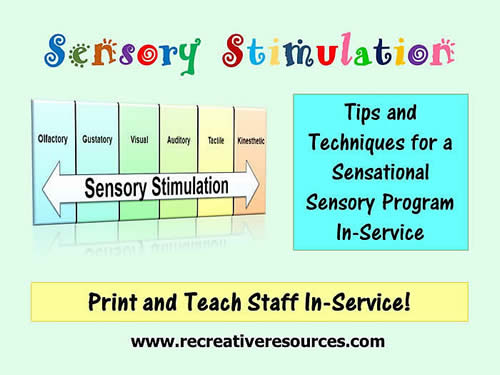Sensory stimulation programs are a critical component of an activity program in long-term care facilities. To have the greatest impact on your residents, sensory stimulation programs and interventions must be individualized and meaningful. The two easiest and effective ways of developing successful sensory programs is by creating individualized sensory boxes and theme-related sensory kits. For a great sensory stimulation in-service, click here!

Individualized sensory boxes can be one of the most effective ways to elicit responses from lower functioning residents, or residents with Alzheimer’s disease or related dementias. The important thing is to gather items that are of greatest interest and importance to the resident and utilize these items during sensory sessions. Once a sensory box is created, label it with the resident’s name and determine the appropriate location to keep the box (resident’s room, nurses’ station, day room, etc.) Maintaining these boxes takes commitment and organization, but is well worth the effort.
The most challenging aspect of creating these personalized sensory boxes is gathering the appropriate materials. One way is to purchase items based on the resident’s initial activity assessment. The dollar store is always a good option, however, some of the greatest sensory boxes I have created came from items provided by family members. Not only is it a wonderful way to gather unique and specific items of interest for a particular resident, but it is also a method of informing family members that the activity department is providing specialized programming for their loved one. The following is an example letter that you may send to the family members.
Dear Family Member,
The Recreation Department of (name of facility) offers sensory stimulation programs, one of the most common types of activities found in long-term care facilities. Simply stated, sensory stimulation is a technique that provides meaningful and common smells, movements, feels, sights, sounds, and tastes through the stimulation of all six senses. There are many benefits to providing sensory stimulation such as increased communication, environmental awareness, relaxation, cognitive stimulation, opportunity to build a rapport, enjoyment of a leisure experience, increased quality of life and much more.
We would like to offer a personalized sensory stimulation program for your loved one by creating a Sensory Box. The Sensory Box will be filled with your loved ones favorite items and is generally used with those residents who are in the later stages of Alzheimer’s Disease or other Dementia related disorders. The box will be utilized by the staff but are also a great tool for you to use during your own visits, making your visits more meaningful.
We really need your assistance in organizing these personalized Sensory Boxes in order to increase your loved one’s quality of life. The more personal, the better! We ask that you please take a few moments to gather some of your loved one’s favorite items and bring them into the facility so we may begin this very important project.
Some suggested items include but are not limited to:
- Personal family photos
- Favorite poems, stories, quotes or books
- Favorite music
- Knick-knacks
- Awards or achievements
- Favorite perfume or cologne
- Religious items
- Pictures or items related to their favorite color, recipes, season, food, hobbies etc.
- Holiday memories
- Items or pictures related to their former occupation
- Items that identify your loved one as a special, unique person
- Recorded voices of family members on a CD or cassette tape
- Family videos or DVD

We really hope that you can help us create a very individualized Sensory Box for your loved one. Please bring in items at your earliest convenience. It is important to remember that items may be lost, or damaged, so please do not bring in items that cannot be replaced. You may drop them off with the receptionist or ask for me personally. I am here (available times). If you have any questions regarding this project, please feel free to contact me at (phone number). Thank you!
Sincerely,
Your name and credentials
Your title
Theme-related sensory boxes or kits are another creative way of providing a success-oriented sensory program. Themes may be based on just about anything: holidays, seasons, cultures, religions, gender, hobbies, colors, celebrations, and so on. Most activity calendars reflect a theme or several themes throughout the month and it is very simple to incorporate theme-related sensory into the monthly calendar. There are many ways in which to gather items for these sensory kits.
- Ask for donations (advertise: “Your junk may be our treasure!”)
- Look around your office and storage areas
- Look around your own house
- Dollar store
- Or you can purchase kits from Nasco, S & S etc.
An important aspect of creating these theme-related sensory kits is to ensure that each kit is meaningful and appropriate for the residents. For instance, men’s sensory programming is often challenging for activity professionals. Click here for some examples of male-oriented kits.
The most creative kits are created in advance and incorporate all of the senses.
Save the day by creating these fantastic sensory boxes and kits based on the residents’ interests and various themes. It takes some planning and organization at first, but if maintained and stored appropriately, less preparation will be needed in the future. The residents will benefit from your SOS (success-oriented sensory program) more than you can imagine!
|







